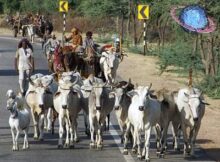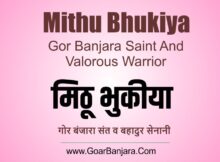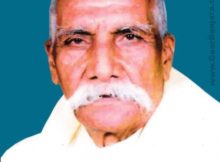Taangadi Kholer
The relatives are given lunch with sweets on the next day or sometimes a goat is sacrificed to the reigning deity and a feast is given to the relatives. All the women from the Tanda gather in the groom’s house in the afternoon and the belongings in the Taangadi given to the bride are shown to all. Also gifts and other things brought for distribution are handed over to the concerned. The relatives and other women are introduced to the bride. Bride bows in front of her mother-in-law and elder women. Prior to touching their feet she massages them for a while and then along with the cloth on head she bows in front of them. As a blessing she is told:
“ताडो सिलो कर, जलंम जोडा ऊतर”
Meaning: May your sorrows and hardships go away and you be blessed with happiness and peace. Long live the couple.
Ek Jaag Karer
After worshipping the gods and goddesses the couple performs honeymoon. The sister-in-law or another woman confines the couple inside a room. They are teased and told to switch off the lights and close the door. This is called as ‘Ek Jaag Karer.’
Rituals of Death
When a person dies a word ‘Samagol’ or a phrase ‘Shaat Wego Aate Re’ is used. The Gor Banjaras consign the dead body to flames or bury it. Women never attend this event. After the ritual is over the Tanda members go to the deceased person’s home to console his relatives. They take water in hand and offer their condolence to the bereaved family. An old relative says on this occasion:
“सामळो भाई ये पाले माईर गोदडीन सराळं लेन पाडे सरीक पडावु ढळगेच केळावंट छ मुऐन मटी जीवतेन बाटी अब रोओ दिकोä मत आपळेन बी येच वाटेती जायर छ”
Meaning: Listen, O brothers, we have lost a brave fellow like a mountain from our Tanda and Paal. There is a saying: ‘Bread to the living, soil to the dead.’ Do not grieve; do not get disheartened. We have also to follow the same route.
Post-death rituals are followed in this tribe. All the relatives collect donation and sacrifice a goat and gave the food to the bereaved family. On the tenth day all relatives go away from the Tanda and prepare bread from wheat flour and put jaggery, butter oil etc. to make an item called ‘Churamo.’ The Churamo is eaten at the same place and the post-death ritual is completed.
Gor Clothing Style and Dialect
Ancient history of any tribe is hidden in its clothing style. Especially the tribal people who live in groups have religious importance for clothing. The dialect expresses its ancient form. Normally references are found regarding Clothing Style and Dialect. The geographical aspect is also important. References about climate, environment, its structure etc. are found in dialect. Clothing Style and Dialect give rise to a tradition. It undergoes change at a very slow pace. The changes occurring in Clothing Style and Dialect are due to civic life, another community and due to tendency of living away from other communities. This tribe has protected its Clothing Style and Dialect in 21st century also. The change occurred over the time is superficial in nature but its core is intact. In our country, the province, social life and type of the tribe can be identified on the basis of its clothing style and dialect. And the lifestyle, food habits, rituals and customs, festivals have become the core issues. They are the foundations of the life of this tribe. The Gor Banjara, especially the women can be easily identified by her clothing style. We can predict the region on the basis of its pronunciation. Ramnarain Upadhyay in his book ‘History of Nimad Culture’ has mentioned about the clothing style of Gor Banjaras: ‘Men wear Dhoti and Kurta and Turban (Pheta). Women prefer huge circular skirt (lehenga), decorated blouse (Kanchuki) and designed head cloth (Odhani). They keep a piece of wooden stick on their head and draw the head cloth over it. They wear ivory bangles, which cover their arm from collar to the elbow while ornaments made from bronze are tied around the ankle.
Phetia (Skirt)
The clothing style of Gor Banjara women is immediately spotted. They use a bright red coloured cloth measuring 7-8 meters called Phetia. The ‘Phetia’ is also known as ‘ghaghro.’ They make it at home. Two circular ribbons are attached to it to fix it on the body. Circular strips are woven with needle for the waist. They are called as ‘Lepo.’ A border of 2-3 inches width is attached to the lower portion of Phetia. It is called as ‘Lawan.’ Using an invaluable cloth called ‘Musaru’ for the ‘ghaghra’ was considered as a prestige issue. Such expensive Ghaghra is worn on special occasions.
Kachali
The blouse is made at home only. It is colourful in nature. The front portion has designs on it and the backside is open. It is tied on the back with 7 threads. The upper portion of the blouse on the front side is circular in spare. Small mirrors are woven on it. It is called as ‘mandav.’ They are woven on both sides of the blouse. One more mirror is woven specially on the stomach area under the navel. It is called as ‘Peti.’ Sometimes the women use the Peti to see their face in it. Also the mirrors are woven on both the hands and it is called ‘Kharya.’
Odhani (Head Cloth)
The ‘Odhani’ also called as ‘Chunari’ is 2-3 meters long. It is also called as ‘Phadaki’ or ‘Tukari.’ It is beautifully designed. A belt woven in small mirror is attached to the upper portion of the ‘Chunari.’ It is called as ‘Ghunghto.’ Earlier the women used to sew all clothes like Phetia, Kachali and Odhani by hand only. Based on her clothing pattern it can be decided whether the woman is a widow, married or unmarried. Unmarried girls wear a Ghaghra of 3 meters. They wear a complete blouse instead of the Kachali. They take a Chunari over their head which is not designed and its remaining portion is wrapped on the chest in special style on the chest and further taken on the back of the left shoulder. This Chunariya has a small but beautifully woven mirror on it. It is called as ‘Kalonshya.’
Ornaments
A Gor Banjara woman wears ornaments weighing almost 5 to 6 Kilograms on her body from head to toe. Unmarried girls and widows do not wear ornaments meant for a married woman. The ornaments wore by an unmarried woman include Ghughari, Wakadi, Muthiya; Kanya in ears; Bindiwani Taroti; specially tied hair; ghughri on both sides of the cheeks; hasali gope, Sakali, Mungar Haar, Rapiyar Haar, Kankhora; bangles of ivory in hand, Chudi, Begad, Kasotya; Mutiya, Bodalu and Chudi on the arms; Pulla and Witi on fingers; Wakadi and Paye-kas on the feet; Machali, Chataka Aguntala on the fingers of feet etc.
The ornaments wore by young girls are: Ghughara and Zaparya pair on the feet; Topali on the cheeks; Mungar Necklace, Gartali, Hasali and Titari around the neck; bangles in the hand; Bamatya and Koparya on the arms; a long garland from waist to toes (called as Sadak); Bhuriya in the nose etc. They make their hair in a special way. The hair is divided in two equal parts and a Ghunghari and two Topalis are attached in the two corners. An ornament called ‘Aati’ is placed behind the hair. Two flowers of wool are woven on the ‘Chunari’ and two small horns of silver are placed in the Chandola. The head cloth is neatly placed on the head because of these two horns. It gives an impression of heightened top. To improve the beauty of the head cloth small horns are used. This ornament resembles the ‘Aati.’ The hairstyle is also unique in nature. A woman cannot neat her hair on her own. Another woman helps her in the job hence she makes her hair after every eight days. The Aati is placed behind the head. A small purse (Potadya) is attached to the Aati. Most of the ornaments were made up of gold and silver. The nose rings, Wakadi, Zanjarya, Kasa were of gold while the Aati was made of copper. A Gor Banjara woman decorated with ornaments like Munga, Kandi, small mirrors, Garatali, and beads looks very attractive. The women have fond of ornaments. Especially women who attend functions like marriages with full preparation attract attention of all. They do not apply vermilion on the forehead instead tattoo on their body.
Designed Handicrafts
These include, ghunghato, zalar, kachali, phetiya darani, lawan, khalchi, galano, kothalo, chunchi, zolana, kasotya, gajara, chhewatya, sheli, kas, sadak, lapo, peti, mandar, aati, potadya, godadi, wasali, kachalir, petiyar dor, wakhara, taangadi and guni.
Style of Men
Men wear a Kurta (Bandi – Rajasthani). They have a big handkerchief on the shoulder, a big turban (Pagadi) of orange colour on head. The length of the turban is 60 to 70 hands long (a length of hand is a measure used in old times). The ornaments include Kalda around the collar, a silver chain, Kalandori, Waistband to keep money, Wasali, chain of Mercury etc. Gor Banjara men grow moustache and beard. In hairstyle they keep Zalpa (Patches) near the ears. They wield a cane in one hand and wear shoes. In general the Gor Banjara men’s clothing style was matching with the men from Rajasthan.
Food Habits and Lifestyle
Normally the Food Habits and Lifestyle also determine the tribe and its religion. The lifestyle is affected by the geographical climate. Food Habits and Lifestyle of people living in North India, mountain ranges, South India and those living near seashore differ. In this case we need to take into account the tribes, religions, and traditions. The effect of food habits is also seen on the attitude of a person. The physical structure of a typical Gor Banjara male comprises, fairly white to darkish colour, long arms, strongly built body frame, glowing face, sharp eyes, medium sized eyes, strong nose and average sized lips. He has lots of hair on head and body as well. They have physical as well as mental capacity to face any situation. These people are very brave and believe in themselves. They have the capacity to work hard, are average in their anger and hatred and can take revenge. If they put faith in somebody then they will sacrifice themselves but will not betray him. Adhering to the promise, not tolerating to any wordy abuse, not forgiving any personal rivalry charity, religiousness and simple at heart are the hallmarks of the Gor Banjara.
Food Habits
Wheat is the main agricultural produce in Nimad and Malawa hence Gor Banjara mainly uses it as staple diet. Along with the transport of foodgrains (Ladeni) agriculture was their second profession. They cultivate Jowar, Wheat, Moong, Udad, Tunwar, Teel (Sesame), Bhadali, Groundnut etc. Chapatti made up of wheat is their favourite. Many types of rotis and recipes are prepared with wheat flour. The chapatti of wheat is called Bati. The chapatti made by hand by applying oil is called Patali Bati. The guests are treated with Patali Bati, soup of jaggery, Daal etc. The Bati is made by hands or also on an earthen pot. Other items like Poori, Lapasi, Kadhav, Kheer-churmo, Chilama, Halawa and Chapatti made of gram flour and jaggery are their favourite.
The non-vegetarian food items give their lunch or dinner completeness. These people were inhabitants of mountain ranges and had a penchant for poaching. Therefore they used to kill antelopes, rabbits, boar, birds etc. The game of wild boar gives them immense pleasure. The people who kill the boar are called as Surama Mati. They also eat chicken, goat, fish, tortoise, crabs etc. with equal delight. After the sacrifice (Naroja) is given to the goddess smaller portions of the meat are distributed to all. The blood of the killed animal is gathered and by adding salt to it a dish called ‘Saloi’ is prepared. The meat of goats and sheep are treated with respect. The Naik is given main portions of the animal. Otherwise it is considered as an insult to him. This custom has led to fights in the Tanda on number of occasions and people have suffered injuries.
The meat is cooked on a fireplace made up of 3 stones. The running water is used for drinking purpose. Boti and Bati is their favourite food. They boil the pieces of meat and eat them. It is called as Botir Nangawan. They like meat prepared with hot spices very much. If a sweet item is prepared in home then it is not necessary that it should be given to the neighbouring households but the meat is certainly distributed at least in small quantity to neighboring 3-4 houses. Lot of milk is available from the cows. Butter is prepared from it and naturally used in large quantity in the meal. Children are given milk to drink in the morning.
Hot Drinks
Gor Banjaras are known for their penchant for various foods. They like a wine made from flowers of Mahua tree very much. The tribe has suffered great loss due to habit of liquor and meat still they can’t do without it. The guests may not be offered tea but certainly a glass of wine in their honour. And occasions of any festival and ritual are incomplete without the liquor. If a child is born and even if it dies liquor is consumed. Even prior to worship a small amount of liquor is poured in front of the deity and then it is taken for drinking. Before taking the 1st sip 2 drops are sprinkled on the floor in the name of the god and then only it is consumed. Substances like Ganja and Afeem are smoked through pipe. Especially the aged people sit on a cot in the courtyard and enjoy a specially made Hookah. In every Tanda it is a common scene that 2-4 people are sitting on a cot and enjoying the pipe. Bidi (rolled leaves stuffed with tobacco) and tobacco are also used for smoking.
Bhang (Hemp)
A concoction of Bhang (Hemp) is prepared on the occasion of marriage and given to all for drinking. It gives a kick. Consuming liquor and becoming unconscious is part of the religious ritual. On the occasion of Diwali a goat is sacrificed while the Padwa (1st day of the new year) is celebrated with hunting a wild animal. Eating, drinking and merry making have become essentials of their lifestyle.
Paan Chhalia
Gor Banjaras are habituated to eat Paan Chhaliya (a preparation of betel leaves). Paan Chhaliya is donated to gods on the occasion of rituals like marriage. The folk songs also have numerous references on this habit. Those with a penchant for Paan maintain a designer purse with them. They make the Paan and insist on others to eat it. The tribe is addicted to Paan Chhalia’s prestige and honour.
This is all regarding their lifestyle, food habits and clothing. The clothing style may look like Rajasthani still the style of women is different. The eating habits are different. They have an attitude of non-vegetarian food like Kshatriyas. Overall the effect of South Rajasthan is observed on their life. It is quite natural. Numbers of tribes are still living in Rajasthan but those who have left Rajasthan for various reasons have maintained their age-old tradition wherever they settled.









